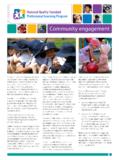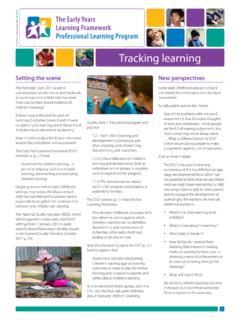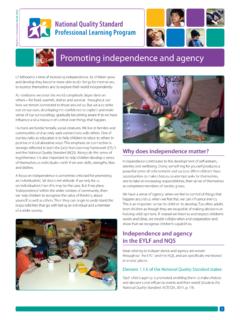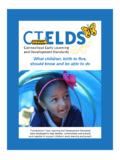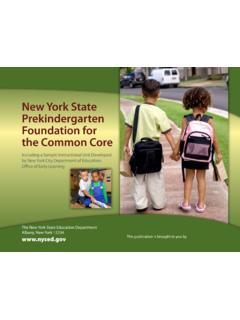Transcription of The Early Years Learning Framework: Building …
1 The Early Years Learning framework : Building confident learnersLeonie ArthurResearch in Practice SeriesThis publication is provided as part of the Early Years Learning framework Professional Learning Program About Early Childhood AustraliaEarly Childhood Australia actively promotes the provision of high-quality services for all young children from birth to eight Years and their families, and supports the important role of parents. Early Childhood Australia is also the national umbrella organisation for children s services and a leading Early childhood publisher.
2 About the seriesThe Research in Practice Series is published four times each year by Early Childhood series aims to provide practical, easy to read, up-to-date information and support to a growing national readership of Early childhood workers. The books bring together the best information available on wide-ranging topics and are an ideal resource for children s services workers and others interested in the care and education of young children. Series Editor Faiza Cheema Edition Editor Sandra Cheeseman Graphic Design Marie Lake Photographs Andrew SikorskiInvitation to authorsIf you are interested in writing for the Research in Practice Series or any other Early Childhood Australia publication, please contact the Publications Section for further information on the preparation of manuscripts and for a copy of the guidelines for , publishing and general enquiriesEarly Childhood Australia Inc.
3 PO Box 86 Deakin West ACT 2600 T: (02) 6242 1800 F: (02) 6242 1818 Sales line: 1800 356 900 (freecall) E: Copyright 2010 All rights reserved by Early Childhood Australia Inc. Material herein must not be reproduced in any form without the written permission of Early Childhood Australia for posting as a publication PP232100/00036 ISSN 1440-5148 ISBN10 1-921162-40-6 ISBN13 978-1-921162-40-4 Printed by Elect Printing, CanberraAbout the authorDr Leonie Arthur is Head of Program, Early Childhood Education, at the University of Western Sydney, where she lectures in curriculum and Early literacy.
4 She was a member of the Charles Sturt led consortium that worked on the development of the Early Years Learning framework . Leonie has been a long-time member of Early Childhood Australia (ECA). She has been actively involved in the work of ECA as a member of ECA NSW Executive and as State Early Years Learning framework : Building confident learnersii1 Introduction 4 What are dispositions?6 What are Learning processes?8 How do children transfer and adapt Learning from one context to another?9 How do children resource their own Learning ?
5 10 How can we help children to be confident and involved learners ?2527 ReferencesAcknowledgements2426 ConclusionUseful resourcesContentsResearch in Practice Series Volume 17 Number 1 2010iiResearch in Practice Series Volume 17 Number 1 20101 This book is second in the Research in Practice Series designed to complement Belonging, Being & Becoming: The Early Years Learning framework for Australia (DEEWR, 2009). The first book, The Early Years Learning framework : Getting started (Goodfellow, 2009), encourages educators to consider multiple starting points in their engagement with the Learning framework .
6 This publication, The Early Years Learning framework : Building confident learners , explores how educators can help children to be confident and involved learners Outcome 4 of the Early Years Learning framework (DEEWR, 2009). Introduction Engaged educators are active in their own learningActive and critical engagement in Learning is also a key characteristic of effective educators. Educators support children s engagement through their warm relationships and when they respond enthusiastically to children s questions and involve them in lively conversations about interesting objects and events.
7 Engaged educators are also active in their own Learning and they critically reflect on and adjust their practice. For this reason, throughout the book there is a focus on reflective practice and examples of educators engaged in critical reflection. Engagement is central to Learning in all areas of the curriculum and for all children (Munns et al., 2006). When children are really engaged in Learning , they show concentration, persistence and eagerness in their inquiry. They have a positive attitude towards tasks and expect to succeed.
8 Research indicates that children from low socio-economic backgrounds and children whose language and culture are in the minority are at greater risk of becoming disengaged from Learning than are children from other groups (Halpin, 2003). It is important in terms of equity and social justice that strategies are implemented to assist all children to be confident and involved learners (DEEWR, 2009).The Early Years Learning framework : Building confident learners2As emphasised in the Early Years Learning framework (EYLF), the indicators for each outcome are provided for guidance.
9 They are not an inclusive list. You can add many other examples based on your observations of the children in your setting and your conversations with children and families. Children will take many different pathways in their Learning . It is important that we expect all children to succeed and make progress towards meeting the Learning outcomes in their own way and in their own time. The examples in this book show how some children demonstrate their progress towards meeting these outcomes and how some Early childhood settings plan, document and reflect on children s Learning .
10 Mary Bailey House, a long day care centre for children from birth to school-age, has also provided examples used in this book. This centre employs Early childhood teachers, diploma graduates and staff with no formal qualifications. While Mary Bailey House was not involved in the trial of the EYLF, the educators are actively working with the EYLF document and exploring different approaches to their : The names of the children from both centres have been changed to protect will take many different pathways in their usedThe Infants Home, Ashfield, which was involved in the trial of the EYLF, is one of the centres providing examples included in this book.



